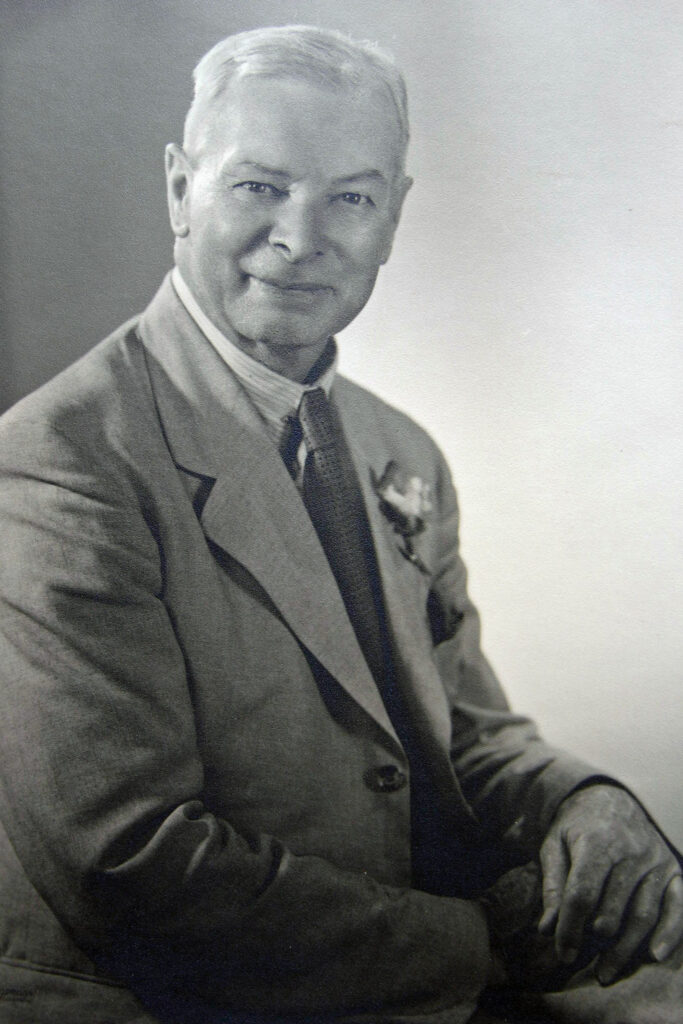
Family History
Paternal Grandfather: John Cook – a ship owner of Ashly, Aberdeen, Scotland.
Paternal Grandmother: Margaret Milne.
Father: William Cook – born in 1855 at Herry Hill, Aberdeen.
Maternal Grandfather: William Miller – a Glasgow City Councilor and part owner of Cotton Mills in Kilmarnock and Dye works in Glasgow.
Maternal Grandmother: Isabella Scott.
Mother: Jessie Miller – born 1853, Sharland’s Villa, Sharlands, Glasgow.
His parents
William Cook arrived in Auckland, 8th September 1879, and started work at the Bank of New Zealand the following day. Jessie Miller arrived on the 19th of August 1881. She and William Cook were married on the 8th of September 1881 at “Boxley”, the residence of Mr. & Mrs Arthur Heather, which later became Sir Frank Mappin’s house in Mount Eden. (Presently this same house is the Auckland residence of the Governor General.) His father, Mr. John Cook was also able to be present at the wedding.
The children
John Arthur Cook – born 9th of September 1882, Epsom.
William Douglas Cook – born 28th of October 1884, New Plymouth.
Sheila Mary Melot Cook – born 25th of December 1891, Mount Eden.
A family on the move
Mr. Cook was an accountant with the BNZ and later a well known BNZ manager in Auckland. The family moved about as Mr. Cook was transferred. Douglas was born in New Plymouth, the family moving on to Oxford in 1886, then to Amberley, back to Oxford, on to Palmerston North and later Woodville before the family moved to Auckland. Mr. Cook died on the 28th of May, 1928. Mrs. Cook died at her home in 4 Tahora Avenue, Remuera on the 16th of July 1935.
Childhood traumas
When he was only two years old Douglas almost poisoned himself by attempting to drink carbolic acid. Before this he had cut his leg under the knee most horribly by kneeling on a sharp table knife and drawing it from under him.
Out on his own
At the age of 17, Douglas left home and in 1903 moved to Hawkes Bay where he worked on Stirrett Orr’s “Rosemount” station at Puketapu, for the leasee Hughie McKenzie. He earned £1 a week as a cowboy. He spent some time at Waipiro Bay working around “Takapau Station” before borrowing £450 from his father to buy 10 acres of the J. N. Williams “Frimley” peach orchard on Omahu Road in Hastings. He was in Hastings for about 4 years but two seasons of frosts destroying the crop put his position there in jeopardy.
A farm at Ngatapa
In 1910 he was successful in drawing sections 1 & 4 in the ballot for the Ngatapa subdivision which he named “Eastwoodhill” after the Miller family home in Thornliebank, near Glasgow. (The family home “Eastwoodhill” had become an old people’s home when Douglas Cook last referred to it in the mid-1960s. Douglas stated that this use of the home would have pleased his grandfather.)
A small two-roomed cabin was built, replaced in 1914 by a larger dwelling.
As to his ability as a farmer, locals speak of Douglas as being a most inadequate farmer. In Douglas Cook’s own words of 1963…
He certainly saw the farming life as an opportunity to do his own thing.
He began planting immediately on taking up “Eastwoodhill”. Roses, flowers, vegetables, orchards and woodlots were planted in that first year 1910. Many seeds of trees and shrubs were purchased and sown. An order of 100 trees & shrubs and 100 Rhododendrons and Azaleas arrived a week or so before he was due to head off to Trentham Camp in 1914 and it was a rush to get these planted.
First World War
Douglas volunteered to serve in the First World War and served in the Light Artillery in Egypt, Gallipoli and lastly France. In Gallipoli he lost the end of a finger to a bullet. In France he lost the sight of his right eye.
The vision of the Garden
He was sent to Britain to recuperate where he stayed with his family in Scotland. He admired the gardens and homes. This was impetus for him to begin planning a garden at “Eastwoodhill”. In his own words…
Implementation of the vision
In 1918, he planted the Poplar Avenue up the Main Entrance drive, closely planted to get the effect he wanted in his lifetime. Little did he realise that things would grow so quickly here. In 1920 some two and a half thousand trees and shrubs for the garden were ordered. An area to the west of the house and also a section that ran to the south, a long strip that included his ‘Cabbage Tree Avenue’, was planted.
